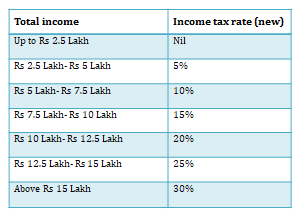The year 2020 started on a positive note with the residential real estate sector showing tangible signs of stability. Early this year, the union budget laid the roadmap of the journey towards a USD 5.0 trillion economy; based on three broad fundamentals of aspirational India, economic development, and caring society.
Everything was sound until the COVID-19 outbreak in March 2020, which dampened the confidence of various stakeholders. The nationwide lockdown, coupled with reverse migration of construction workers, put the sector under immense stress. However, to mitigate the adverse economic impact, the government introduced a slew of policies and measures. As with all long-term propositions, it will take time to see their impact.
In this post, we look back at 2020 and summarise the key events pertaining to the real estate sector.

To simplify existing tax structures and provide relief to individual taxpayers, the government introduced a new concessional income tax rates for those who don’t avail any exemptions. This optional tax system came into effect from April 1, 2020, for FY 2020-21.

The impact: The new tax regime is good for individuals who do not avail any tax exemptions as it will result in more disposable income in their hands. However, it is not suggested for homebuyers as there are no tax benefits either on a home loan or on House Rent Allowance (HRA).

To resurrect the economy by reviving sentiment, the government announced Rs 30,000 Crore infusion in NBFC’s, HFC’s, and micro-finance companies with the help of debt papers and additional 20% emergency credit line to businesses.
The impact: This move is likely to impact the real estate sector positively by bringing in much required liquidity for construction and project completion.

In the second tranche of Rs 20 Lakh Crore economic package, the government announced the one-year extension of the Credit Linked Subsidy Scheme (CLSS) up to March 2021. Since its implementation in 2017, the CLSS scheme has already benefitted over 3.3 Lakh families, and the extension will further aid many more families to avail housing under this scheme.
The impact: The one-year extension will encourage fence-sitter to take the plunge. It will also help push demand for affordable housing, thereby improving the homeownership rate in India.

The Karnataka government slashed the stamp duty on new apartments costing up to Rs 35 Lakh. For properties costing less than Rs 20 Lakh, the existing 5% was reduced to 2%, while for properties costing between Rs 21-35 Lakh, the rate was reduced to 3%.
Similarly, the Maharashtra government also temporarily reduced stamp duty on residential units from 5% to 2% until Dec 31, 2020. Stamp duty from Jan 1, 2021, until Mar 31, 2021, will be 3%.
The impact: The reduction in stamp duty will encourage more people to buy homes. It will also increase the demand for ready-to-move-in properties as OC-ready projects do not attract GST, thereby reducing overall property transaction cost.

The Union Cabinet approved an affordable rental housing scheme for urban migrants and poor. The announcement emanated from the plight of urban poor during the nationwide lockdown imposed due to the Covid-19 outbreak. As economic activities halted, these people were unable to make their ends meet, resulting in the mass exodus of migrants to their native states.
The Affordable Rental Housing Complexes Scheme or ARHCs will be under the purview of the Ministry of Housing and Urban Affairs and will be a sub-scheme under the Pradhan Mantri Awas Yojana (Urban).
Under the scheme, existing vacant government-funded housing complexes will be converted into affordable rental complexes. With an estimated expenditure of around Rs 600 Crore, the scheme aims to benefit nearly 3 Lakh people initially.
The impact: The creation of rental housing stock will help students, working professionals, and the migrant population to find accommodation easily.

The centre also increased the differential rate between the circle rate and the agreement value from 10% to 20%. This will be applicable till June 30, 2021, for only primary sale of residential units of value up to Rs 2 Crore. Currently, Section 43CA of IT Act restricts the differential between circle value and the agreement value at 10%.
The impact: For homebuyers, it is a clear added financial benefit to round off the existing offers and discounts. Additionally, the consequential relief up to 20% to buyers of these units under Section 56(2) (x) of the IT Act for the said period will boost demand, especially in the affordable and mid segments.

Five years after the implementation, Pradhan Mantri Awas Yojana (Urban) has made steady progress across states. To achieve the ambitious Housing for All by 2022, the government, further, announced an additional outlay of Rs 18,000 Crore for PMAY-U.
The impact: The additional outlay of Rs 18,000 Crore will help 12 Lakh houses to be grounded and 18 Lakh houses to be completed. This will help bridge the housing gap in the country to a good extent.

Last but certainly not the least, in an attempt to encourage growth and ease liquidity, the RBI cut repo rates multiple times this year. Currently, the repo rate and reverse repo rate stands at 4% and 3.35% respectively.
The impact: Low repo rate translates to low-interest rates on home loans. Thus, reduced stamp duty rate coupled with low-interest rates makes it a good time for people to enter the market.
All said and done, with these measures announced in 2020, the industry hopes that the road ahead into 2021 will be much smoother than the year that went by.

